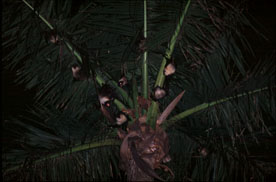

Many microbats have various facial protuberances,used in echolocation,which
make it hart to refer to them as "cute". Fruit bats don't echolocate
and have large eyes designed to be efficient at twilight. Their bodys are
plump and furry. They are so cute!! Combined head and body length is about
20cm and wingspan can be as much as about 90cm.
They live in subtropical and tropical areas. Ryukyu Flying Foxes living
in Kuchinoerabu are the northernmost of all the world's flying foxes. In
winter they become less active in the low temperatures and are difficult
to find, but they don't hibernate.
Bats have four very long fingers and a short thumb to each wing. The wing
membranes are attached to the fingers and to the legs. They have a claw
on the second finger in addition to the claw on the thumb. These are used
to manipulate fruit and leaves.
Fruit bats make audible sounds. When two
individuals meet they hit each other with
their wings and scream loudly. Large colonies
are occasionally very noisy with monkey-like
screams. As fruit bats roost in trees out
in the open their loud chattering can be
heard from far away.
Fruit bats feed almost exclusively on fruit. They crush the fruit to extract
the juice and spit out the pulp. The droppings are liquid. They look like
bird droppings but lack uric acid crystals. They drop seeds in flight over
a wide area, giving them a good chance of germination. Sometime they eat
the pollen and the nectar of the flowers of mescal,palm and garcinia and
so help in pollination. When fruit and flowers are in short supply in the
woods they also eat leaves. Fruit bats have a good sense of smell. Many
tropical fruits and flowers that bloom at night have scents that attract
fruit bats.
Fruit bats don't use echolocation and have keen vision. As they can't see
in total darkness,. they fly using moonlight,starlight and townlight. During
the day they roost in trees not caves. Sometime they fly during the day.
There are few bat biologists so the life of fruit bat has not, as yet,
been well studied. I have read that P.d.daitoensis mate in November
and December,but I have watched them mating at the end of the year and
into the new year. Babies are born in May or June. Their roosts are not
always permanent. They roost in small groups or singly. Sometimes they
roost in large colonies. Bonin Flying Foxes in Titijima Island have large
fixed colonies from January to April. They wake up at sunset. When the
sun sets and the sky darkens their voices are heard from the roost. About
30 minutes after sunset they assemble at the feeding site. For the following
2 or 3 hours they are very active feeding and chasing each other. As night
draws on they disperse and rest. They begin to return to the roost 1 hour
before sunrise and go to sleep at dawn. Sometime ,when it is cloudy, they
don't return to the roost until after sunrise.